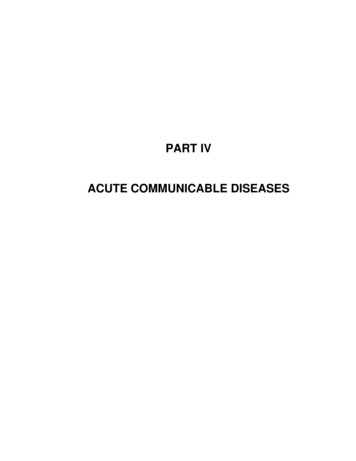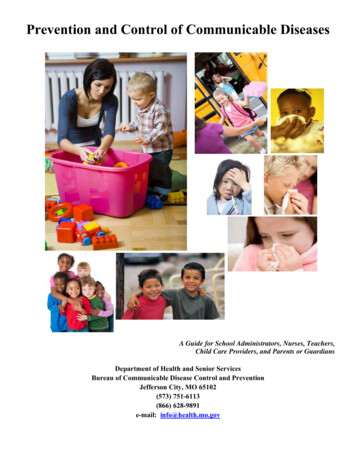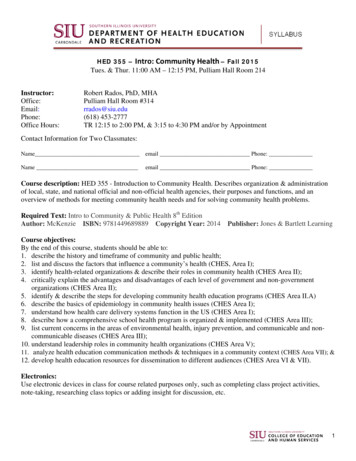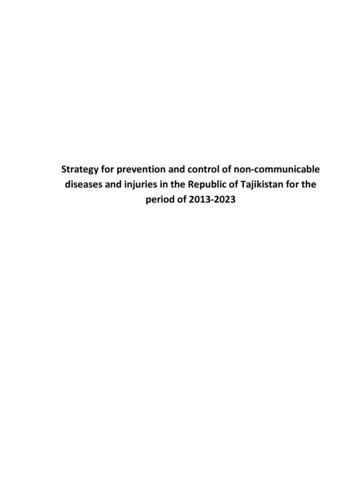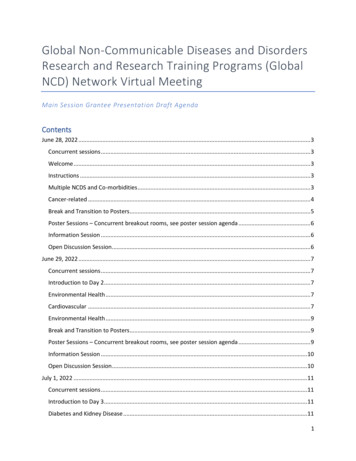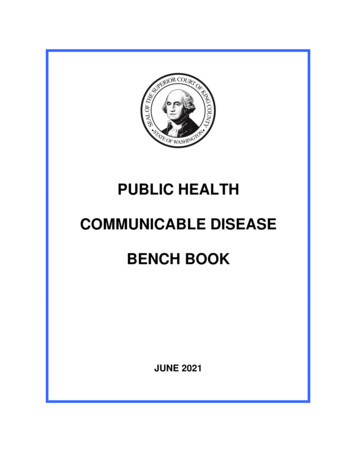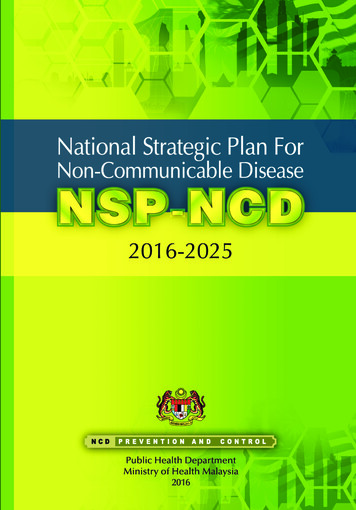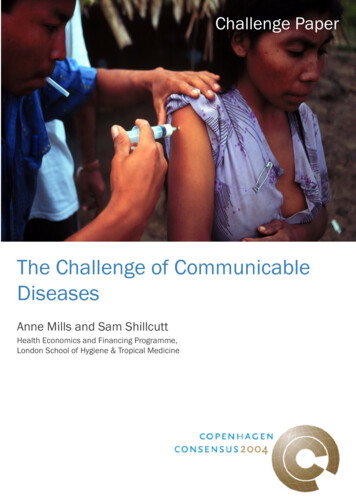
Transcription
Challenge PaperThe Challenge of CommunicableDiseasesAnne Mills and Sam ShillcuttHealth Economics and Financing Programme,London School of Hygiene & Tropical Medicine
This paper was produced for the Copenhagen Consensus 2004project.The final version of this paper can be found in the book,‘Global Crises, Global Solutions: First Edition’,edited by Bjørn Lomborg(Cambridge University Press, 2004)
Copenhagen Consensus Challenge PaperNot to be released before 16 April 2004Copenhagen ConsensusChallenge Paper on Communicable DiseasesAnne Mills and Sam Shillcutt*Health Economics and Financing ProgrammeLondon School of Hygiene & Tropical MedicineFebruary 2004*Anne Mills is Professor of Health Economics and Policy and Head, Health Economicsand Financing Programme, London School of Hygiene and Tropical Medicine, KeppelST, London WC1E 7HT; tel 44 207 927 2354; email anne.millls@lshtm.ac.uk.Sam Shillcutt is Research Fellow in the Health Economics and Financing Programme,London School of Hygiene and Tropical Medicine; tel 44 207 927 2090 emailsam.shillcutt@lshtm.ac.ukAcknowledgementsAM and SS are members of the Health Economics and Financing Programme (HEFP)which is funded by the Department for International Development of the UnitedKingdom. However the Department for International Development can accept noresponsibility for any information provided or views expressed. We are very grateful toCatherine Goodman and Fern Terris-Prestholt for comments on the final draft, and moregenerally to our HEFP colleagues for support in tracing literature and discussion ofdrafts.1
Table of ContentsAcknowledgementsList of FiguresList of TableExecutive summary13341The challenge of communicable disease82Assessing the opportunities112.1 The economic benefits of improved health and the availability of evidence 112.2 Methodological approach adopted153Control of malaria3.1 Identification and description3.2 Alleviation of the challenge – interventions3.3 Side effects3.4 Economic evaluation3.5 Feasibility1818232425364Control of HIV/AIDS4.1 Identification and description of opportunity4.2 Alleviation of the challenge – interventions4.3 Side effects4.4 Economic evaluation4.5 Feasibility3939454647505Strengthening basic health services5.1 Identification and description5.2 Alleviation of the challenge5.3 Side Effects5.4 Economic Evaluation5.5 Feasibility5252535354566Discussion and Conclusions58Annex – Complete summary of results62References642
Figures1.1 Life expectancy at birth, 1955-20022.1 Channels through which illness reduces income3.1 Effect of resistance on treatment failure4.1 Long-run economic costs of AIDS in South Africa8113343Tables1.1 Leading causes of death in children in developing countries, 20021.2 Risk of dying and avoidable mortality (%) in low- and middle-incomecountries 19982.1 Value of a DALY/YLL3.1 Cost-Benefit Ratios in Malaria Control3.2 Costs and benefits of malaria control estimated from macroeconomic models3.3 Costs and benefits of ITNs3.4 Costs and benefits of IPTp3.5 Costs and benefits of changing from SP to ACT3.6 Costs and benefits of scaling up ACT3.7 Costs and benefits of a package of malaria control measures4.1 Effects of HIV/AIDS on national GDP 2000-20254.2 Effect of HIV/AIDS on long-term GDP: No action taken4.3 UNGASS HIV/AIDS recommendation4.4 Net benefit in terms of 2000 national GDP by 20254.5 Costs and benefits of Thailand’s 100% condom programme 1993-20004.6 Benefit cost ratios of interventions for SSA4.7 Cost and benefits of the UNGASS package of interventions for middle andlow- income countries5.1 The WDR 93 minimum heath package5.2 Costs and benefits of increased health expenditure 2002-20155.3 Costs and benefits of the 1993 World Development Report Package5.4 Relaxing constraints: priority actions by type of country6.1 Summary of key results9916262729313434354444464748495053555556603
Executive summaryThe challenge of communicable diseaseOver the second half of the twentieth century, the world has seen enormous healthimprovements. However, developing countries have benefited unequally from healthgains, with many, especially in sub-Saharan Africa (SSA), continuing to experiencehigh mortality. Children bear a major burden of ill health, with infectious and parasiticdiseases the main killers. Adults experience substantial premature mortality. Withincountries, poorer groups have considerably worse health than the better off. Analysis ofavoidable mortality highlights the importance of communicable disease, whichrepresents around 90% of all avoidable mortality in almost all age/sex groups. Thebenefits of research mean that tools and approaches now exist to address the greatmajority of the burden of communicable disease, most notably malaria, TB, andHIV/AIDS, as well as vaccine preventable diseases. However, large numbers of peopledo not have effective access to prevention and treatment, and as a result die.The paper focuses on three opportunities: Malaria control HIV/AIDS control Strengthening basic health services.This categorisation has been chosen largely because malaria and HIV/AIDS are majorcauses of disease burden and economic losses; cost-effective interventions are known toexist for their control; there is recent literature which can be drawn on to estimate costsand benefits; and these diseases are currently the focus of world attention. Basic healthservices have been chosen as the third opportunity since they address a major part of thedisease burden, and represent explicitly the infrastructure that needs to be in place forpeople’s main health needs to be met.The economic benefits of improved healthThe relationship between illness and income is complex. Effects are felt both directly(through the immediate impact of ill health on productive activities) and indirectly, viathe effects of illness on fertility, morbidity, mortality and intellectual capacity, andhence on the labour force size, composition and quality, and on the capacity of countriesto engage in the global economy. Empirical studies of the relationship between diseaseand economic outcomes fall into two categories: microeconomic and macroeconomic.The former study the link between disease/ill health at household or individual level,usually documenting the costs imposed by disease on households but not explicitly thebenefits of disease control, and categorising costs as direct and indirect. Such estimatesare likely to underestimate the true economic impact of a disease, since they neglect theimpact of coping strategies and the broader, dynamic consequences of disease for theeconomy as a whole. In contrast, macroeconomic studies assess the influence of adisease on national income in cross-country comparisons. In principle they are betterable than microeconomic studies to reflect the wide-ranging and dynamic implicationsof ill health, but raise concerns as to the extent to which other influences on economicgrowth are adequately allowed for. Again such studies usually document the cost ofdisease, but only by implication the benefits of disease reduction.4
The most abundant literature is that on the cost-effectiveness of interventions,comparing intervention cost with benefits expressed in terms of health outcomes.Systematic approaches have recently been applied to the synthesis of bothepidemiological studies and economic studies, making judgements on the quality ofevidence, and facilitating conclusions on both health outcomes of interventions andcost-effectiveness. However, using these studies to evaluate the efficiency of healthinterventions in units that are comparable across economic sectors requires placing amonetary value on human life.Given the limitations of the literature in terms both of quantity and quality, and the needto be comprehensive and consistent, estimates of costs and benefits were where possiblecalculated by the authors based on the literature rather than limiting the paper only tocosts and benefits actually provided in the literature. Several different approaches wereadopted. For the two diseases (malaria and HIV), evidence was drawn from threedifferent sources: Studies of the macroeconomic impact of the disease Studies of the cost-effectiveness of interventions Evidence of the costs and health benefits of large scale country programmes.For basic health services, evidence was drawn from two different sources: Regression analyses that measured the efficiency of health expenditure in generatinghealth outcomes The costs and health benefits of a package of interventions recommended in the1993 World Development Report.Where possible, costs and benefits were summarised as both annualised net benefits(ANB) adjusted for Purchasing Power Parity and benefit cost ratios (BCR). A year oflife lost was valued at 2003 per capita Gross National Income (GNI) (the ceiling ratio),and a discount rate (DCR) of 3% applied. In sensitivity analyses, the DCR was set at 6%and the ceiling ratio at the mean GNI for low and middle income countries of Int 3,830.Control of malariaMajor reductions in the malaria burden and its eradication from temperate parts of theworld gave reason for optimism in the mid twentieth century. However, in the 1980’s,commitment to programmes waned and resistance to medicines and insecticidesincreased. With the increased use of new combination drugs and a greater internationalcommitment to financing malaria control, there is again reason to believe that theburden of malaria can be substantially reduced. SSA experiences over 90% of theglobal burden of malaria; malaria causes around 20% of the mortality of children under5; and it is the most important single infectious agent causing death in young children.Cost-benefit estimates were therefore made for SSA, drawing on macroeconomicstudies; on cost-effectiveness studies of insecticide-treated mosquito nets, intermittentpresumptive treatment of pregnant women (IPTp), and combination therapy (ACT); andevidence from recent successful malaria control efforts in the KwaZulu Natal provinceof South Africa. Based on estimates from macroeconomic models, we predicted thatthe ANB of eliminating 50% of malaria between 2002-15 would be Int 11-43 bn, withBCRs of 1.9-4.7. For the package of malaria control measures these were Int 47.4 bnand 27. The ANB of the successful South African malaria control programme wasInt 9m, and it was cost saving.5
Control of HIV/AIDSThe HIV/AIDS pandemic is devastating the economies of many low- and middleincome countries. Current estimates are that more than 22m people have already died,34-46m are currently living with HIV/AIDS, and 5.3m new infections occur each year.The scale of the problem is such that it is considered a development issue and globalsecurity threat. The costs and benefits of approaches to addressing the epidemic wereestimated, drawing on four different sources of information: a macroeconomic model ofthe gains to prevention in several north African and Middle Eastern countries at the‘nascent’ stage of the epidemic; the costs and benefits of successful control in Thailand,at the ‘concentrated’ stage of the epidemic; evidence on the cost-effectiveness of anumber of specific interventions in Africa; and estimates of the cost and health impactof the UNGASS global programme. For the group of North African/Middle Easterncountries, intervening now was estimated to save 15-30% of 2000 GNP by 2005. InThailand, the ANB of the AIDS control was Int 3.5 bn and BCR 15. BCRs ofindividual interventions were highly variable but generally exceeded 2, with condomdistribution and blood safety having BCRs of 466. The UNGASS package had ANB ofInt 359.4 bn and BCR of 50.Basic health servicesThe great majority of health interventions depend for successful and sustainedimplementation on an infrastructure of basic health services, consisting of communitybased services, health centres, and local hospitals. These can address much of theburden of ill health including that from maternal and neonatal conditions, childhoodillnesses such as diarrhoea, ARI and vaccine preventable diseases, and malaria, TB andHIV/AIDS. Over the last decade recommendations have been made on a package ofpriority interventions to be delivered at this level. We estimated the costs and benefitsof scaling up basic health services drawing on firstly evidence for HIPC countries of therelationship between health expenditure and health gains and the necessary increase inpublic spending to reach the MDG child mortality target; and secondly estimates of thecosts and health benefits of the package of interventions recommended in the 1993World Development Report. The first approach gives ANB of Int 50.0 bn and BCR 3.9(though benefits for children only are included). The 1993 WDR package gives ANBof Int 534.1 bn and BCR of 2.6.ConclusionsAll sources of data used have severe shortcomings, which must inform the interpretationof the costs and benefits. In particular: The macroeconomic literature is quite inadequate; The microeconomic literature comes mainly from interventions implementedindividually in the context of epidemiological trials; evidence of costs and healtheffects of large scale programme implementation is very limited. Health effectswere translated into a monetary value using a somewhat arbitrary ceiling ratio. For the basic health services opportunity, benefits for children only are valuedalthough other population groups are likely to benefit. Evidence from successful programmes is hard to interpret, since external factorsmay also have affected changes in health effects.In addition, our estimates suffer from other shortcomings:6
Available costs were usually costs to the provider, excluding costs to usersResource savings were rarely included in the estimatesWe were unable to be explicit on which groups would benefit most under each ofthe challenges, and in particular on the extent to which the poorest would benefit.Finally, macroeconomic estimates of benefits and calculations made from costeffectiveness evidence cannot of course be assumed to be reflecting the samedimensions of benefits.Given the weakness of the evidence base, it would be unwise to read too much intodetailed differences between or within opportunities. However, a clear message fromthe calculations is that in general, the benefits from investing in communicable diseasecontrol greatly exceed the costs. It remains unclear whether greater priority should begiven to controlling one specific disease, such as malaria or HIV/AIDS, or to a packageof priority health services, and the decision will depend to a considerable degree on totalfunding available. However it cannot be emphasised enough that these threeopportunities are not completely independent – both malaria and HIV/AIDS controlmust include a substantial component of strengthening health services if they are to besuccessful.Finally, it should be noted that the productivity of health expenditure is likely to begreater both in a supportive policy environment, and where complementary investmentstake place, for example in female education.7
1. The challenge of communicable diseaseOver the second half of the twentieth century, the world has seen enormousimprovement in health. Between 1960 and 1995, life expectancy in low incomecountries improved by 22 years, in contrast to 9 years in developed countries (1).However, developing countries have benefited unequally from health gains (2): thelarge life expectancy gap between developed and developing countries in the 1950s haschanged to a large gap between developing countries with persisting high mortality(mainly in SSA), and those who have experienced rapidly falling mortality (Figure 1.1).For example, average adult life expectancy is below 40 years in several countries in thedeveloping world, particularly in those severely affected by HIV such as Botswana.Sierra Leone has the highest mortality rates for infants and children under 5 years old inthe world (3).Figure 1.1: Life expectancy at birth, 1955-2002 (WHO 2003)Life expectancy at birth (years)807060504030Developed20Developing – low mortality10Developing – high mortality019401960198020002020YearOf the 57m deaths in the world in 2002, nearly 20% were children under 5, and 98% ofthese were in developing countries (4). Communicable diseases represent 7 out of thetop 10 causes of child deaths in developing countries, and account for around 60% of allsuch deaths (Table 1.1). Just over 30% of all deaths in developing countries are ofadults aged 15-59, in contrast to 20% in developed countries, representing a substantialproblem of premature adult mortality with strong economic implications. Withincountries, the poorer groups have substantially poorer health than the better off: forexample in Cambodia under five mortality in the poorest quintile, 147 per 1000, wasthree times that of the richest quintile, and in the Central African Republic, under fivemortality of 189/1000 in the poorest quintile was double that of the richest quintile (5).8
Table 1.1 Leading causes of death in children in developing countries, 2002 (2)RankCauseNumbers (000)% of all deaths1Perinatal conditions2 37523.12Lower respiratory infections1 85618.13Diarrhoeal diseases1 56615.24Malaria1 09810.75Measles5515.46Congenital anus1851.810Protein-energy malnutrition1381.3Other causes1 43714.0Total10 263100The analysis of avoidable mortality undertaken by Working Group 5 of the Commissionon Macroeconomics and Health (CMH) highlights the importance of focusing oncommunicable disease (1). Avoidable mortality is a population’s excess risk of dyingbefore age 70, as calculated by comparison with the death rates in another population: inthis case non smokers in the richest countries. Table 1.2 shows that almost 90% ofdeaths in children under five are avoidable, and 84% of deaths in women aged 5-29.Avoidable mortality due largely to communicable disease represents around 90% of allavoidable mortality in all age/sex classes other than middle aged men, for whom it is80%.Table 1.2: Risk of dying and avoidable mortality (%) in low- and middle-income countries, 1998 (1)Males at ages5 to 29 30 to 696.135.0Females at ages0 to 4 5 to 2930 to 698.25.626.7Risk of dyingLow- and middle-income countries (a)0 to 48.6Nonsmoking, high-income population (b)1.22.219.21.00.912.6Excess risk of dying (avoidable mortality) in low- andmiddle-income countries (c a – b)7.33.915.77.24.714.2Relative contribution of avoidable mortality to risk ofdying in low- and middle-income countries (d c/a)866345888453Relative contribution of Group 1* causes to avoidablemortality919480939791*Communicable diseases, maternal conditions, perinatal conditions, nutritional deficienciesHistorically, rapid declines in mortality have been the result of access to better housing,sanitation and education, growing incomes, and public health measures such asvaccination. The benefits of research mean that tools and approaches now exist toaddress the great majority of the burden of communicable disease, most notablymalaria, TB, and HIV/AIDS, as well as vaccine preventable diseases. This helps toexplain the current international focus on tackling these diseases. However, as Table1.1 demonstrates, large numbers of people do not have effective access to preventionand treatment, and as a result die. For example, coverage of DPT31 is under 50% forchildren in households living below the poverty line of 1 per day (5); and only 2% of1The third dose of the DPT vaccine, commonly used as a proxy for vaccination coverage9
children are protected from malaria by sleeping under insecticide treated mosquito netsin Sub-Saharan Africa (6).The control of communicable disease is achieved by some combination – depending onthe disease – of action through a health service infrastructure and through specifictargeted efforts which in some instances depend on the infrastructure and in others areindependent of it. Hence the evaluation of the case for controlling specificcommunicable diseases cannot ignore its relationship with the health system. However,issues of whether successful health improvement can be achieved by general healthsystem strengthening, or by targeted efforts focused on specific diseases, have been thesubject of considerable controversy (7). The reality is that with the very unusualexception of diseases that can be eradicated (notably smallpox in the past and polio inthe future), sustainable health improvement requires some combination of astrengthened and accessible health service plus focused efforts to strengthen the controlof priority diseases. Nonetheless, given limited resources, there are choices to make,which this paper seeks to evaluate.The paper has chosen to focus on three opportunities: Malaria control HIV/AIDS control Scaled up basic health services.As emphasised above, this definition of the opportunities should not be taken to implythat these are completely distinct efforts. Expanded and improved basic health servicesare a precondition for malaria and HIV/AIDS control, though also address a muchbroader range of conditions including other communicable diseases such as acuterespiratory infections, diarrhoeal diseases, TB, vaccine preventable diseases, andmaternal/perinatal conditions. This categorisation of opportunities has been chosenlargely because malaria and HIV/AIDS are major causes of disease burden andeconomic losses; cost-effective interventions are known to exist for their control; thereis recent literature which can be drawn on to estimate costs and benefits; and thesediseases are currently the focus of world attention. Basic health services have beenchosen as the third opportunity since they address a major part of the disease burdenaffecting poor countries, and represent explicitly the infrastructure that needs to be inplace for people’s main health needs to be met.The following section provides an overview of the economic benefits of improvedhealth, discusses the availability of evidence, and outlines the overall approach taken inthe paper to estimating costs and benefits. Subsequent sections address eachopportunity. A final section discusses methodological weaknesses and limitations, anddraws conclusions.10
22.1Assessing the opportunitiesThe economic benefits of improved health and the availability ofevidenceHealth has both consumption and investment benefits. In other words, it is valued forits own sake, as well as a means to achieve other goals (such as a good income). Therelationship between illness and income is complex, as illustrated in Figure 2.1 (8).Effects are felt both directly (through the immediate impact of ill health on productiveactivities) and indirectly, via the effects of illness on fertility, morbidity,Figure 2.1: Channels through which illness reduces income (Ruger, et al 2001)Higher fertilityandchild mortalityHigherdependencyratioLabor forcereduced bymortality andearly retirementLowerper capitaincomeChildillnessChildmalnutritionLess schoolingand impairedcognitive capacityLaborproductivityreducedAdultIllness andmalnutritionReduced accessto naturalresources andglobal economyReducedinvestment inphysical capitalmortality and intellectual capacity, and hence on the labour force size, composition andquality, and on the capacity of countries to engage in the global economy.Disease has been shown to have a major impact on the economy through these effectson productivity, education, and investment. As people fall ill, they are less likely to beable to work and less likely to be productive if they can. People have weaker incentivesto invest in their education if it is uncertain that they will be alive to reap the benefits.There is also less incentive for people to save for their retirement, as shorter life spansreduce the value of saving and investment in productive assets. As foreign investorswithdraw their money from these areas, the economic costs of disease are exacerbated(9). However, it has been argued that effective intervention can thrust the economy justas powerfully in a positive direction. Better health can lead to a demographic transitionand economic growth in the long term. Initial reductions in child mortality are followedby a decline in fertility. As the flood of new children mature and reach working age,and a larger proportion of people are able to contribute to the economy, the wealth ofthe society rises substantially as is argued to have happened in East Asia between 196511
2 (9). The massive improvements in public health that occurred in East Asia between1965-1990 most powerfully show these effects, and may have accounted for as much as1.68% of its economic growth during this period (10).The CMH recently argued that the impact of health on economic development has beenunderestimated (8, 11), and that health improvements globally during the 20th centurycontributed as much, or more, to improvements in economic welfare as the innovationsand expansion in material goods and services. Such conclusions have been drawn fromstudies which seek to explore the determinants of economic growth, and in particularthe influence of improved health status. From the perspective of this paper, thisliterature presents two problems: it is not disease specific; and it does not address wellwhat type of action might best improve health.Empirical studies of the relationship between disease and economic outcomes fall intotwo categories: microeconomic and macroeconomic. The former study the link betweendisease/ill health at household or individual level. Usually they document the costs thatdisease imposes on the household, but not explicitly the benefits of disease control.Costs are commonly categorised as direct (household and government expenditure onprevention and treatment), and indirect (loss of productivity due to illness and death).There are strong reasons to believe that this simple methodology does not measure thetrue economic impact of a disease, not least because in response, households and firmsadapt their productive activities, or ‘cope’. Coping mechanisms are defined asstrategies adopted by family members, friends and colleagues to minimise the effects ofan illness on the welfare of all concerned (12). Sauerborn et al. identified 11 differentkinds of household coping behaviours in response to illness episodes of all kinds inrural Burkina Faso (13). The most commonly used strategy was intra-household laboursubstitution in response to lost work time of household members. Direct costs wereusually met by mobilising cash reserves and savings, selling livestock, or receiving giftsfrom other households.Such strategies may have knock-on effects through depleted capital stock, lost savingsand indebtedness. The sale of assets such as livestock potentially jeopardises thehousehold asset base, with households emerging more vulnerable and less able to copewith further crises (13). A household without livestock, and unable to rely on gifts, maybe forced to take out loans which could lead to serious debt and future impoverishment(12). These knock-on effects ultimately affect supply or production through low savingand investment. Furthermore, this means that the causal relationship by which diseaseaffects the economy may not necessarily be through sick labour only, but also throughlost capital and purchasing power.The potential for labour substitution crucially affects the degree to which any loss oftime is translated into a loss of output. Unemployment and underemployment arecommon features of underdeveloped economies, and farming is often undertakencommunally, in households or extended families. In the event of temporary disability ofa household member, the family workforce may provide a cushion, limiting theconsequent loss of output. During some seasons, agricultural underemployment may beso prevalent that time lost by sick individuals can be fully compensated for. Similarlyin the industrial and service sectors, other members of the workforce may cover to someextent for sick colleagues.12
However, even if market output were maintained, there may be costs associated withlabour substitution, depending on the value of the activities from which the substitutinglabour is withdrawn (12). Moreover, assessment of a single measure of householdoutput, such as agricultural production, will not capture the total impact on householdwelfare as it ignores the quantity and quality of home production such as foodpreparation or child care, and participation in other activities, such as education orsocial organisations.Coping strategies are likely to respond not only to actual illness, but also to the risk ofdisease. The risk of poor health status may have a pervasive effect on economicincentives, behaviour and strategies (14). Households and firms respond withanticipatory coping strategies, ranging from insurance mechanisms to changes in theorganisation of productive activities (12). Although formal insurance is rare indeveloping countries, informal mechanisms are common, including social networks andcommunity organisations, and incur administrative costs which produce efficiencylosses in comparison with a risk-free setting. Precautionary measures affecting theorganisation of economic activity are likely to have wide-reaching economic effects.High rates of absenteeism may engender labour supply responses such as limiting staffspecialisation and maintaining labour reserves to reduce the risk of labour shortages atkey times of the year, reducing the average labour productivity of all staff. Householdsmay respond to the risk of high financial expenditure for serious illness by reducingtheir level of investment, or investing in assets which have higher liquidity but lowerreturns. Finally, the risk of disease may affect reproductive as well as productivestrategies, for example increasing desired family size to insure against high rates ofchild mortality and increase th
and Financing Programme, London School of Hygiene and Tropical Medicine, Keppel ST, London WC1E 7HT; tel 44 207 927 2354; email anne.millls@lshtm.ac.uk. Sam Shillcutt is Research Fellow in the Health Economics and Financing Programme, London School of Hygiene and Tropical Medicine; tel 44 207 927 2090 email sam.shillcutt@lshtm.ac.uk .


